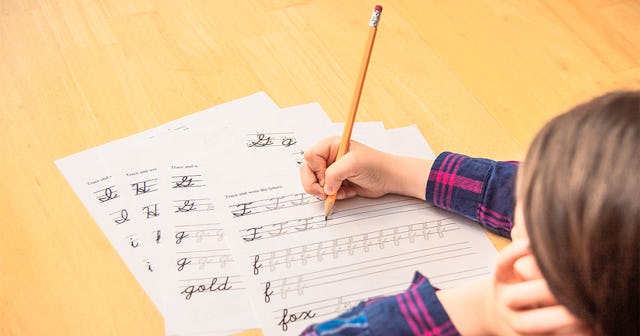IDGAF If You Think It's 'Outdated' — Why I'm Teaching My Kids Cursive

Every weekday morning, I pull out those dotted three-lined sheets — you know the ones — and make my three sons’ handwriting sheets. They whine. They moan and tear their hair and we have to wait for various ADHD drugs to kick in before we can even think about touching them. “I hate learning cursive,” nine-year-old August tells me. Repeatedly. Every morning.
“You need to,” I reply heartlessly, because I am history’s greatest monster. “Most high school students can’t read cursive. Well, at least a lot of the ones I know.”
There’s a lot of dissension in the ranks over this one. And yet, we persevere. The Declaration of Independence and the Magna Carta are written in freaking cursive. So is practically every historical document ever. I don’t want my kids to wind up unable to read them. That’s an ignorance I simply can’t abide.
9-year-old learning cursive.
My kids aren’t alone. Noelle Mapes, a third-grade teacher at a public school on the Lower East Side of Manhattan, told The New York Times that including cursive in the curriculum “feels like a big nostalgia move… I’m a millennial teacher, so it almost feels like a boomer effort… Add typing skills, anti-racist pedagogy, add activism skills, add digital literacy. There are so many other things.”
We’re lucky enough to homeschool, so I’ve got time for all that. And don’t accuse me of Boomerism. Everyone needs a damn signature. And people write in cursive. Signs and fonts come in cursive. Kids should be capable of reading them so they can move through our world as literate adults. Anyway, cursive is faster.
They are learning cursive. I don’t care what Ms. Mapes has to say.
Learning Cursive Is A Time Investment
Ms. Mapes was right about one thing: learning cursive takes time. We spend about twenty minutes a day, every day, on handwriting. I spend about forty, because I need twenty minutes to make their handwriting sheets, which started out as individual letters and have moved into quotes and poems.
I could use a textbook, but I’m mostly too lazy to shop for one.
Do I need to give tips and pointers to everyone involved? Yes. Learning cursive is hard. There’s a lot of, Stay on the bottom line. O’s look like this, A’s look like this. Try not to lift your pencil up. Teachers would have to have help with it in a class of thirty kids. When my middle son was having massive ADHD meltdowns about it, I literally had to coach him through every single letter. He’s nine, and he still has a lot of trouble with it. But he has a lot of trouble with printing, too.
I do not give up.
Why I Teach My Kids Cursive
My oldest son simply takes his handwriting sheet and completes it. He has pretty good cursive. This is amazing: he has dysgraphia, which affects how he forms letters and spells words. His printing looks like a kindergartener’s, and he’s eleven. Learning cursive gives him a sense of pride and accomplishment. It also gives him a way to freaking write.
11-year-old dysgraphic Blaise’s cursive
My other two sons simply need cursive to move through the world as adult humans. When I design T-shirts, I use cursive fonts. When I walk down the street, I see cursive signs. When I read oh, The Declaration of Independence, I read cursive words, because Thomas Jefferson did not print in neat all-caps for everyone’s ease and pleasure.
It’s part of being a literate person. Cursive is a script we use in English. We should be able to read English script.
Imagine a world in which people squint at the Declaration of Independence. It’s a pretty document. But they can’t read “We hold these truths to be self-evident that all men are created equal.” We can argue about Jefferson’s meaning and motives and mistakes all day long, but as a founding statement, it’s pretty damn glorious.
So my kids can bitch and moan and throw tantrums. In August, they couldn’t form a cursive A. Three months later, my seven-year-old wrote “Ariel’s Song” from Shakespeare’s The Tempest. He didn’t write it perfectly. He didn’t stay on the bottom line. I had to re-read it with him before he wrote it. But damn it, he wrote it. They all have legal signatures.
They might moan one day that I taught them cursive and they never use it, except to sign documents.
But at least they’ll be able to read it.
This article was originally published on